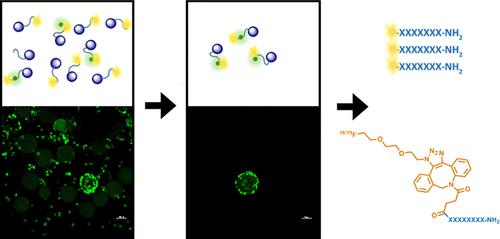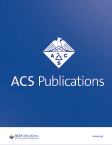用无铜点击化学方法将氟掺入OBOC肽库以发现PET显像剂
IF 3.784
3区 化学
Q1 Chemistry
引用次数: 4
摘要
在筛选库之前,通过无铜点击化学将含19f的片段添加到八聚体肽的n端,开发了一个肽基显像剂的一头一化合物(OBOC)文库。这创建了一个完整的显像剂库,对CXCR4(一种癌症成像感兴趣的受体)进行了筛选。通过筛选,直接发现了一种IC50为138 μM的肽基显像剂。这项概念验证研究描述了一种新型的OBOC肽库设计,其中从筛选中发现的点击可以很容易地转化为它们的氟-18对应物,用于PET成像,而不会失去亲和力。本文章由计算机程序翻译,如有差异,请以英文原文为准。

Incorporation of Fluorine into an OBOC Peptide Library by Copper-Free Click Chemistry toward the Discovery of PET Imaging Agents
A one-bead one-compound (OBOC) library of peptide-based imaging agents was developed where a 19F-containing moiety was added onto the N-terminus of octamer peptides through copper-free click chemistry prior to screening of the library. This created a library of complete imaging agents that was screened against CXCR4, a receptor of interest for cancer imaging. The screen directly resulted in the discovery of a peptide-based imaging agent with an IC50 of 138 μM. This proof-of-concept study describes a new type of OBOC peptide library design, where hits discovered from screening can be easily translated into their fluorine-18 counterpart for PET imaging without loss of affinity.
求助全文
通过发布文献求助,成功后即可免费获取论文全文。
去求助
来源期刊

ACS Combinatorial Science
CHEMISTRY, APPLIED-CHEMISTRY, MEDICINAL
自引率
0.00%
发文量
0
审稿时长
1 months
期刊介绍:
The Journal of Combinatorial Chemistry has been relaunched as ACS Combinatorial Science under the leadership of new Editor-in-Chief M.G. Finn of The Scripps Research Institute. The journal features an expanded scope and will build upon the legacy of the Journal of Combinatorial Chemistry, a highly cited leader in the field.
 求助内容:
求助内容: 应助结果提醒方式:
应助结果提醒方式:


